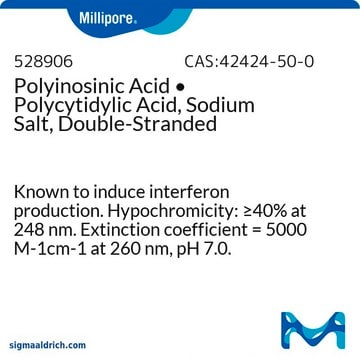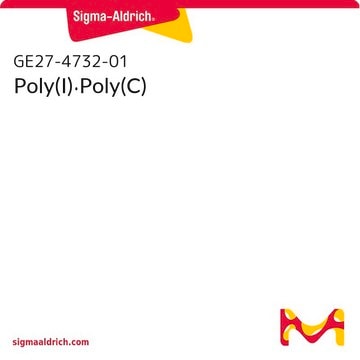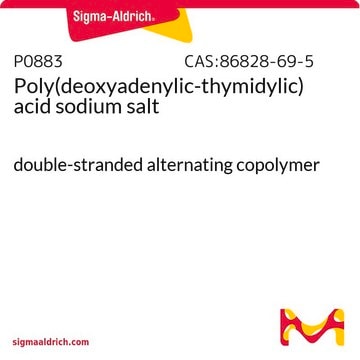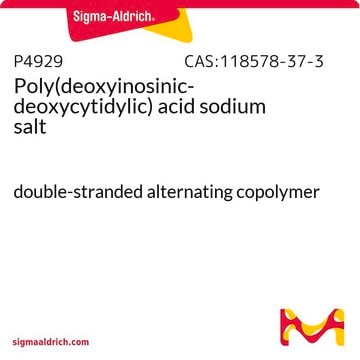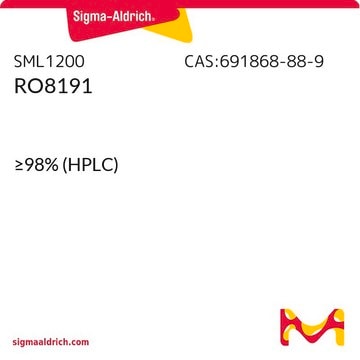The long term stability of this product in solution is not been investigated. However, aqueous solutions are expected to be stable for at least 6 months when stored in working aliquots at -20°C. Please see the link below to review the product datasheet for additional information:
https://www.sigmaaldrich.com/deepweb/assets/sigmaaldrich/product/documents/143/182/p9582pis.pdf
Wichtige Dokumente
P9582
Polyinosinsäure:Polycytidylsäure
with buffer salts, TLR ligand tested
Synonym(e):
Poly (I:C), Poly(I) • Poly(C)
Größe auswählen
Größe auswählen
About This Item
Empfohlene Produkte
Qualitätsniveau
Assay
≥99% (less than 1% free nucleotides, TLC)
Form
lyophilized powder
Zusammensetzung
Poly(I) • Poly(C), 10% (balance buffer salts as sodium chloride and sodium phosphate)
Lagerbedingungen
desiccated
Lagertemp.
−20°C
Suchen Sie nach ähnlichen Produkten? Aufrufen Leitfaden zum Produktvergleich
Anwendung
Biochem./physiol. Wirkung
Verpackung
Sonstige Hinweise
Angaben zur Herstellung
Lagerklassenschlüssel
11 - Combustible Solids
WGK
WGK 3
Flammpunkt (°F)
Not applicable
Flammpunkt (°C)
Not applicable
Persönliche Schutzausrüstung
Eyeshields, Gloves, type N95 (US)
Hier finden Sie alle aktuellen Versionen:
Analysenzertifikate (COA)
Die passende Version wird nicht angezeigt?
Wenn Sie eine bestimmte Version benötigen, können Sie anhand der Lot- oder Chargennummer nach einem spezifischen Zertifikat suchen.
Besitzen Sie dieses Produkt bereits?
In der Dokumentenbibliothek finden Sie die Dokumentation zu den Produkten, die Sie kürzlich erworben haben.
Kunden haben sich ebenfalls angesehen
-
What is the stability of this product in solution? For example, how long would a 5 mg/mL solution last when stored at -20 celcius?
1 Antwort-
Hilfreich?
-
-
What is the size (bp) of this product?
1 Antwort-
This product has a estimated size range of 272 - 4242 bases with a resulting molecular weight range of 90,000 - 1,400,000 daltons.
Hilfreich?
-
-
Does the product P9582-5MG contain 5mg of polyI:C or 500ug (10%) of poly I:C and 4.9mg buffer salts?
1 Antwort-
This product contains 10% Poly (I:C) with sodium chloride and sodium phosphate buffer salts. Please see the link below to a sample Certificate of Analysis for further details regarding concentration of the Poly (I:C).
https://www.sigmaaldrich.com/certificates/sapfs/PROD/sap/certificate_pdfs/COFA/Q14/P9582-50MG0000213739.pdfHilfreich?
-
-
What is the Department of Transportation shipping information for this product?
1 Antwort-
Transportation information can be found in Section 14 of the product's (M)SDS.To access the shipping information for this material, use the link on the product detail page for the product.
Hilfreich?
-
-
How stable is Product P9582, Polyinosinic-polycytidylic acid potassium salt, in solution?
1 Antwort-
RNA and synthetic RNA analogues will be very stable in aqueous solution as long as the solutions are not contaminated with RNase.
Hilfreich?
-
-
What is the molecular weight of Product P9582, Polyinosinic-polycytidylic acid potassium salt?
1 Antwort-
The molecular weight may vary from lot to lot with a range from 90,000 to 1,400,000 with an average of 200,000 to 500,000.
Hilfreich?
-
-
Why is the total mass of Product P9582, Polyinosinic-polycytidylic acid potassium salt, in my bottle much greater than the designated package size?
1 Antwort-
The package size is based on the polynucleotide content. However, since the polynucleotide is supplied with sodium chloride and sodium phosphate buffer salts, its mass represented by the package size is approximately 10% of the total mass present in the bottle.
Hilfreich?
-
-
Should Polyinosinic-polycytidylic acid potassium salt Product P9582 or P1038 be used for cell activation?
1 Antwort-
For cell activation, synthetic double-stranded RNA is widely used as ligand of Toll-like receptor 3 (TLR3) in place of what is supposed to be the natural ligand (viral dsRNA). The double stranded RNA homopolymer, i.e. Poly(I):Poly(C), Prod. No. P9582 can be used for this application. P1038 is a single-stranded RNA and will not activate TLR3.
Hilfreich?
-
-
What is the difference between Polyinosinic-polycytidylic acid potassium salt Products P9582, P1038, P1530 and P0913?
1 Antwort-
Prod No. P9582 as well as Prod. Nos. P1530 and P0913 are double-stranded with one strand of Poly(I) and one strand of Poly(C). Prod. No. P1038 is a single-stranded RNA analog with C and I randomly making up the polynucelotide strand. Double-stranded Prod. No. P9582 is a potassium salt while double-stranded Prod. Nos. P0913 and P1038 are sodium salts. Prod. No. P0913 is gamma-irradiated. None of the other products have been gamma-irradiated. Unlike the other products, only approximately 10% of the total mass of Prod. No. P9582 is actually polynucleotide. The remaining 90% is buffer salts as sodium chloride and sodium phosphate.
Hilfreich?
-
Aktive Filter
Unser Team von Wissenschaftlern verfügt über Erfahrung in allen Forschungsbereichen einschließlich Life Science, Materialwissenschaften, chemischer Synthese, Chromatographie, Analytik und vielen mehr..
Setzen Sie sich mit dem technischen Dienst in Verbindung.
